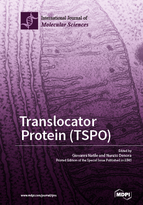Translocator Protein (TSPO)
A special issue of International Journal of Molecular Sciences (ISSN 1422-0067). This special issue belongs to the section "Biochemistry".
Deadline for manuscript submissions: closed (30 September 2016) | Viewed by 68399
Special Issue Editors
Interests: drug delivery; drug targeting; TSPO; imaging; tumors
Special Issues, Collections and Topics in MDPI journals
Interests: transport of anti-tumoral platinum-based drugs and their interaction with proteins and DNA; non-classic platinum anticancer drugs; active trans-platinum compounds; platinum compounds with uncommon coordination numbers and oxidation states and activation of unsaturated ligands
Special Issues, Collections and Topics in MDPI journals
Special Issue Information
Dear Colleagues,
Decades of study on the 18-kDa mitochondrial translocator protein (TSPO), first discovered in the late 1977 as an alternative binding site for the benzodiazepine diazepam in the kidneys, have revealed that this protein participates in a variety of cellular functions, including cholesterol transport, steroid hormone synthesis, mitochondrial respiration, permeability transition pore opening, apoptosis, and cell proliferation. In accordance with TSPO's diverse functions, changes in TSPO expression have been linked to multiple diseases, from cancer to endocrine and neurological diseases. Thus, TSPO has become an extremely attractive subcellular target for: (1) the early detection of disease states that involve the overexpression of this protein; (2) selective mitochondrial drug delivery.
Investigation of the functions of this protein, both in vitro and in vivo, has been mainly carried out using high-affinity ligands, such as isoquinoline carboxamides (e.g., PK 11195) and benzodiazepines (e.g., Ro5-4864). For instance, PK 11195 and Ro5-4864 have been used to explore TSPO distribution and function in various tissues and pathologies, thus allowing for the mapping of the “peripheral binding site” in almost every tissue examined. In time, the number of structurally diverse TSPO drug ligands investigated has increased steeply, thus highlighting the great interest of the scientific community in understanding the functions of this translocator protein in both normal conditions and pathological states.
This Special Issue will consist of reviews and primary data manuscripts, and will focus on: (1) new potent and selective TSPO ligands; (2) the use of ligands as imaging tools for the early diagnosis of diseases characterized by the high expression of TSPO, such as neuroinflammation and TSPO-rich cancers; (3) TSPO targeted nanocarriers that deliver therapeutics and diagnostics; (4) TSPO ligands that could be used to prepare coordination complexes of metallodrugs, for use in diagnosis and therapy; (5) TSPO ligands as pro-apoptotic agents that are potentially useful for the treatment of cancers; and (6) in vitro and in vivo investigations of the ability of TSPO ligands to affect steroidogenesis.
Prof. Giovanni Natile
Prof. Dr. Nunzio Denora
Guest Editors
Manuscript Submission Information
Manuscripts should be submitted online at www.mdpi.com by registering and logging in to this website. Once you are registered, click here to go to the submission form. Manuscripts can be submitted until the deadline. All submissions that pass pre-check are peer-reviewed. Accepted papers will be published continuously in the journal (as soon as accepted) and will be listed together on the special issue website. Research articles, review articles as well as short communications are invited. For planned papers, a title and short abstract (about 100 words) can be sent to the Editorial Office for announcement on this website.
Submitted manuscripts should not have been published previously, nor be under consideration for publication elsewhere (except conference proceedings papers). All manuscripts are thoroughly refereed through a single-blind peer-review process. A guide for authors and other relevant information for submission of manuscripts is available on the Instructions for Authors page. International Journal of Molecular Sciences is an international peer-reviewed open access semimonthly journal published by MDPI.
Please visit the Instructions for Authors page before submitting a manuscript. There is an Article Processing Charge (APC) for publication in this open access journal. For details about the APC please see here. Submitted papers should be well formatted and use good English. Authors may use MDPI's English editing service prior to publication or during author revisions.
Keywords
- translocator protein (TSPO)
- translocator protein 18-kDa
- PBR
- mitochondria
- TSPO ligand
- imaging
- PET
- microglia
- neuroinflammation
- Alzheimer
- steroidogenesis
- drug targeting
- apoptosis
- cancer








